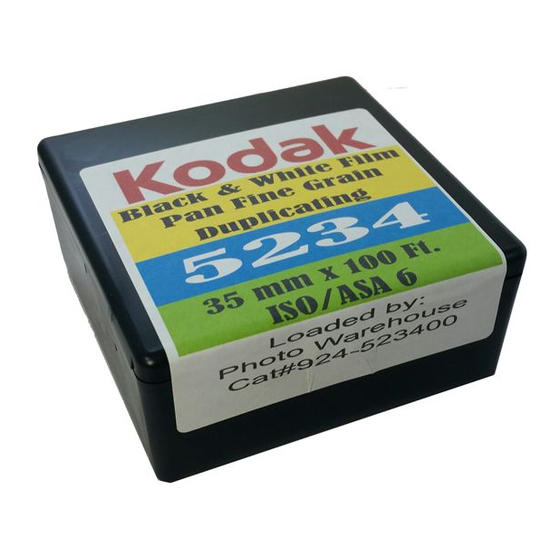
Advertisement
Quick Links
EASTMAN Fine Grain
Duplicating Panchromatic
Negative Film 5234, 7234
TECHNICAL DATA
EASTMAN Fine Grain Duplicating Panchromatic Negative
Film 5234/7234 is a panchromatic film characterized by
very high sharpness. This low-speed, black-and-white film
is designed for making duplicate negatives from master
positives, or internegatives from reversal originals. When
used with EASTMAN Fine Grain Duplicating Positive Film
5366/7366, it produces negatives nearly equal to the
original negative in tone rendering and printing detail.
BASE
5234/7234 Film has a gray acetate safety base. The back
side of the base contains an anti-static layer with a
carnauba wax lubricant.
DARKROOM RECOMMENDATIONS
Use a KODAK No. 3 Safelight Filter / dark green, with a
15-watt bulb, no closer to the film than 1.2 metres (4 feet).
STORAGE
Store unexposed film at 13°C (55°F) or lower. For extended
storage, store at -18°C (0°F) or lower. Process exposed film
promptly. Store processed film according to the
recommendations in ANSI/PIMA IT9.11-1998: for
medium-term storage (minimum of ten years), store at
25°C (77°F) or lower at a relative humidity of 20 to 50
percent; for extended-term storage (for preservation of
material having permanent value), store at 21°C (70°F) or
lower at a relative humidity of 20 to 30 percent. For active
use, store at 25°C (77°F) or lower, at a relative humidity of
50 +/- 5 percent. This relates to optimized film handling
rather than preservation; static, dust-attraction and
curl-related problems are generally minimized at the
higher relative humidity. After usage, the film should be
returned to the appropriate medium- or long-term storage
conditions as soon as possible.
For more information about medium- and long-term
storage, see ANSI/PIMA IT9.11-1998, SMPTE RP131-1998,
and KODAK Publications No. H-1, KODAK Motion Picture
Film, and No. H-23, The Book of Film Care.
©Eastman Kodak Company, 2013
PROCESSING
The following process recommendations should be used as
starting points for most conventional
continuous-immersion processors with solutions prepared
according to the formulas in KODAK Publication
No.H-24.15, Manual for Processing KODAK Motion Picture
Films, Module 15. The processing times may require
modification for a particular machine.
Note: Observe precautionary information on product
labels and on the Material Safety Data Sheets.
Processing Step
Temperature
KODAK
70 +-1/2 F
Developer
(21 +-0.3 C)
*
D-96
Stop Rinse
‡
70 +-2 F
(21 +-1 C)
KODAK Fixing
70 +-2 F
Bath
(21 +-1 C)
F-5
*
Wash
70 +-2 F
(counter-current)
(21 +-1 C)
Dry
95 F (35 C)
*
Agitation in the developer and fixing bath should be by recirculation through
submerged spray jets that impinge on the film strands.
†
Develop to recommended control gamma.
‡
Countercurrent flow of fixer-laden water overflow from the wash tank, pH
about 6.
¶
Many factors affect the drying: air temperature, relative humidity (RH);
volume, rate and distribution of the air flow; final squeegeeing, etc.
In a conventional convection-type drying cabinet with
air at about 95°F (35°C) and 40 to 50 percent RH, drying
will take 15 to 20 minutes. With an impingement-type
drying cabinet, however, with a higher temperature and
lower RH, drying time is greatly reduced. With either type
of dryer, the film should be dry without tackiness 1/2 to
2/3 of the way through. Upon cooling to room
temperature after leaving the dryer, the film should be in
equilibrium with the room air at approximately 50 percent
RH.
April 2013 • H-1-5234t
Time
Replenishment Rate
(mL per 100 ft)
35 mm
16 mm
1250
625
†
-
(D-96R)
(D-96R)
50 sec
12,000
6000
11 min
850
425
10 min
12,000
6000
¶
-
Advertisement

Summary of Contents for Kodak EASTMAN 5234
-
Page 1: Technical Data
† Developer (21 +-0.3 C) (D-96R) (D-96R) D-96 Use a KODAK No. 3 Safelight Filter / dark green, with a 15-watt bulb, no closer to the film than 1.2 metres (4 feet). Stop Rinse ‡ 70 +-2 F 50 sec... - Page 2 Base Density not apply directly to a particular box or roll of photographic material. They do not represent standards or specifications that must be met by Eastman Kodak Company. The F010_0020AC company reserves the right to change and improve LOG EXPOSURE (lux-seconds) product characteristics at any time.
- Page 3 MORE INFORMATION Outside the United States and Canada, please contact your Kodak representative. You can also visit our web site at www.kodak.com/go/motion for further information. You may want to bookmark our location so you can find us easily the next time.















Need help?
Do you have a question about the EASTMAN 5234 and is the answer not in the manual?
Questions and answers